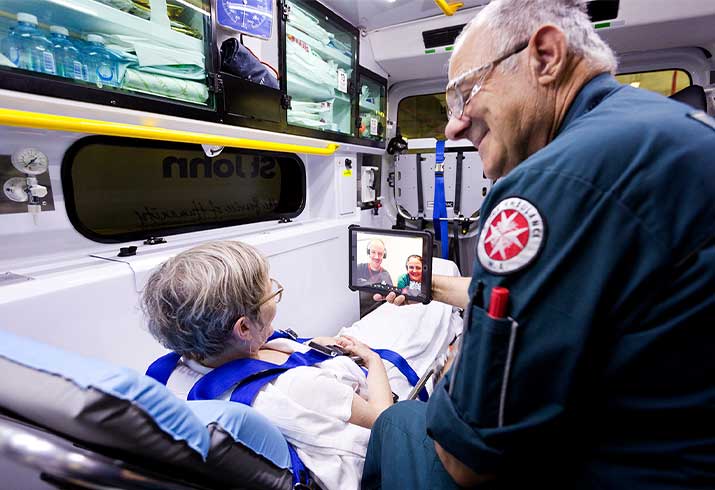SMHS Virtual Emergency Medicine service set to expand
 St John WA Paramedic with patient using video call to talk with VEM Clinicians.
St John WA Paramedic with patient using video call to talk with VEM Clinicians.
South Metropolitan Health Service (SMHS) in collaboration with St John WA ambulance is changing the face of emergency medical care with the first-of-its-kind in Australia Virtual Emergency Medicine (VEM) service, shown to reduce patient wait times and improve ambulance and emergency department (ED) flow.
The VEM virtual triage system has operated from the Fiona Stanley Hospital (FSH) command centre since February, using video call technology to communicate with paramedics in the back of an ambulance, before hospital arrival. It allows patients to be assessed and triaged before they arrive to the ED or diverted to another suitable inpatient service.
The service welcomed a $2.3 million funding boost from the State Government this week, which will allow its expansion from the current FSH base to both Rockingham General Hospital (RGH) and Peel Health Campus (PHC).
FSH ED Consultant and VEM Project Clinical Lead Dr Ian Dey said VEM was a game changing emergency medicine model that, with the extra funding, had the potential to significantly ease pressures on busy EDs and improve patient care and flow throughout hospitals and the wider WA health system.
“VEM aims to provide the right care in the right place at the right time, and this may not be in the ED,” Ian said. “Through collaboration with St John WA ambulances, residential aged care facilities and community-based services, VEM can stream ambulance patients directly to the most appropriate healthcare service for their needs.”
Staffed by a clinical nurse and emergency physicians, the 7 days-a-week service has tele-consulted and tele-triaged 1250 ambulance patients to appropriate healthcare services since its inception.
“During the first month of its pilot phase this year, VEM was successful in diverting 28% of incoming ambulances to alternate care pathways in the hospital, and for those patients referred to VEM, ramping was reduced by 25%,” Ian said.
ED Consumer Advisory Group representative Jane Pearce said VEM provided efficient, patient-centred care that involved family, carers and healthcare professionals in care planning.
"VEM has the potential to greatly improve the patient experience by allowing safe, timely, person-centred care to be provided in the home, in a residential aged care facility or in the community, instead of in the ED,” Jane said.
